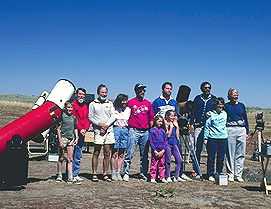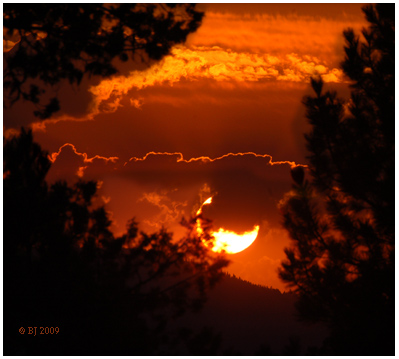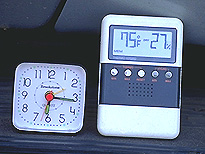Oregon
Star Party History Main Page by Bruce Johnson, Group Photographer
OSP BEGINNINGS: The Oregon Star Parties in 1988, 1989, 1990, and
1991 were all held high on Steens Mountain in extreme Southeastern
Oregon, This is one of the most remote and darkest sky locations
in the entire United States! "Visibility" at Steens
ranks among the highest still left in the United States (see page bottom for facts)!..... Steens Mountain rises in Harney County,
near the Nevada border...
 From 1992 to the present (2014),
we have held OSP in the Ochoco Mountains near Prineville, Oregon,
not nearly so high and remote, but still very dark skies.
From 1992 to the present (2014),
we have held OSP in the Ochoco Mountains near Prineville, Oregon,
not nearly so high and remote, but still very dark skies.
To the left is
the first official OSP Group Photo. It is from the 1989 event.
We were tiny and intimate back then.....Our 1989 Group Photo shows
11 Stalwart Astro parents and kids relaxing at our observing site,
a 7,400 ft high dry lake bed near Fish Lake on the west slopes
of Steens Mountain.......... OSP Director Chuck and his wife Judy
are on the far right. Author's Son Russ is on the far left. The
OSP Committee members at that time were only four: myself, Chuck,
Judy, and Candace. Find pictures of OSP 88 on the next page....For a complete story on "Big Red," the classy Coulter 10-inch Dob
seen on the picture's left side,click here. Click here to see some classic OSP labels on Big Red!
OSP 2009
 Sunset
Sunset
|
OSP
1991- Steens |
Steens Mountain tour |
Gary
and Carolyn Find OSP Ochocos site. Sorry, as of 2018-defunct |
Links, eg. Oregon Astronomy,
Artists and Galleries, Save the Gribble Barn, and GoSaab |
|
Meet
Your Photographer |
OSP, Indian Trail Spring, Ochoco Mtns '92-'98.
Includes 1994, and 1995 with John Dobson and Richard Berry |
OSP's
new totem tree, the Lightning Tree (1995), plus
section on the danger of Fire Closing down the OSP |
|
2003 Group Photo, OSP Ochocos... (tour
the waters of Indian Trail Springs) |
2002
Group Photo |
2001
Group Photo and link to page about OSP tickets and raffles! |
............
 Typical
OSP late afternoon temperature and humidity are ideal! Your optics
stay dry at our 5,000 ft. site in the Ochoco Mountains of Central
Oregon! Sunburn Risk at OSP is high even though we typically hold
our event a full two months after Summer Solistice.
Typical
OSP late afternoon temperature and humidity are ideal! Your optics
stay dry at our 5,000 ft. site in the Ochoco Mountains of Central
Oregon! Sunburn Risk at OSP is high even though we typically hold
our event a full two months after Summer Solistice.
OSP UVB levels
and Sunburn dangers at OSP---
Beware! UV intensity at OSP is usually much higher than you are
accustomed to! In 2011, OSP was held more than two months after
the Summer Solistice; nevertheless, I recorded a very high 374
on September 2nd; but back at my home in Olympia, Washington two
days later I could only coax a reading of 272 out of my meter,
and two days after that, on an apparently clear days, I could
only get 238! At OSP 2011, even late morning UVB levels were over
300; eg. a strong 317 at 11:20am (Daylight time) on Saturday!.
.... And back at OSP 2008, even higher readings were obtained,
a blistering 390, despite the date of August 30th!
This 390 reading is 140 points higher than I could coax out of
my meter during the next few days after OSP at my home in Olympia,
Washington (a result which I replicated in 2009)! For a full discussion
of UVB levels and research in Oregon, click here. In relation to the high elevation of OSP, pay
special attention to the section detailing late-season UVB readings
at the comparable elevation of Timberline
Lodge.
Back
to OSP Main Page
Visit
my Steens Mountain/Alvord Desert pages
Visit the Official OSP site's History
Pages
Back
to OregonPhotos Main Page
Page
last revised 10/27/2023
"Visibility"
Lovers of the
out-of-doors delight in distant panoramas, but many have noticed
with disappointment that days with crisp, clean air and fine distant
panoramas are rarer and rarer all across the U.S...... historical
accounts of early Oregon often mention the pleasing views of very
distant mountain peaks available even from within the lowlands
of the Willamette Valley, while early mountaineer's accounts mention
feats of distant vision that astound the climbers of today, and
which may never be rivalled again...... A good example are reports
from such high points in Central Oregon as Paulina Peak that the major peaks
from Oregon, California and Washington were all visible at one
time, the minimum distance involved being 180 miles from 8,000
ft. Paulina Peak to 14,000 ft. Mt. Shasta in California, and 160
miles to 12,000 ft. Mt.
Adams
in Washington. (see below)
"Typical
visual range in the eastern U.S. is 15 to 30 miles, or about one-third
of what it would be without human caused air pollution. In the
West, the typical visual range is 60 to 90 miles, or about one-half
of the visual range under optimal natural conditions. Haze diminishes
the natural visual range.
Haze is caused
by fine particles that scatter and absorb light before it reaches
the observer. As the number of fine particles increases, more
light is absorbed and scattered, resulting in less clarity, color,
and visual range." Source: Official Dept. of Agriculture
Site: http://www.fsvisimages.com/viscause.html
"Dark
Skies vs. Light Pollution"
Recently
I came upon a really evocative article about the light pollution
problem facing our World as a whole. The writer, Verlyn Klinkenborg,
in this November 2008 National Geographic article, wrote:
"In
most cities the sky looks as though it has been emptied of stars,
leaving behind a vacant haze that mirrors our fear of dark and
resembles the urban glow of dystopian science fiction. We've grown
so used to this pervavsive orange haze that the original glory
of an unlit night - dark enough for the planet Venus to throw
shadows on Earth - is wholly beyond our experience, beyond memory
almost. And yet above the city's pale ceiling, utterly undiminished
by the light we waste - a bright shoal of stars and planets and
galaxies, shining in seemingly infinite darkness."
 Sunset
Sunset